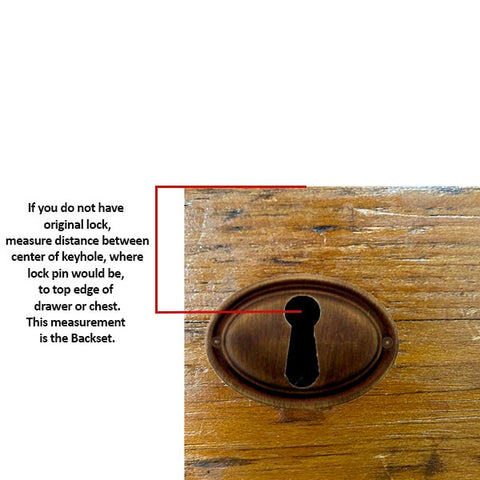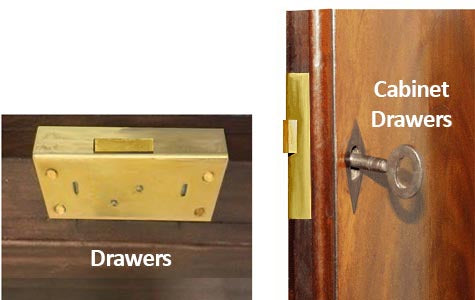Expert Advice - Competitive Prices - Dependable Quality
Expert Advice - Competitive Prices - Dependable Quality
Hardware
How to Measure - Install Half Mortise Locks

What you need to know about selecting and replacing half mortise locks
Half Mortise Locks are a traditional lock style used on 18th, 19th and 20th century furniture. They offer a semi-concealed appearance. The keyhole is all that is seen on furniture exterior. A simple flush plate is seen on interiors of furniture.
There are two types of half mortise locks:
 |
Half Mortise Drawer LocksHalf Mortise Drawer Locks are fitted into top portion of drawer interior. Lock is only visible from inside of drawer.
Half Mortise Door Locks
|
 |
Half Mortise Box LocksBox locks are specifically designed for boxes and chests with lift lids. They can only be used for this type application. These box locks require a strike plate with hooks. When lid is closed, strike-hooks drop down into lock and are secured by locking mechanism.; When replacing a lock, ensure the backset measurement corresponds precisely to the distance from the center of the circular portion of the keyhole in furniture to the top edge of the drawer or side edge of the door. If the backset matches but the overall lock box size is different from what’s required, modifying the mortise may be necessary to achieve a proper fit. |
Measuring Half Mortise Locks:
New Construction

- Consider placement of keyhole cover on drawer, chest or box as this could affect actual keyhole location
- Keyhole location determines required backset measurement for lock.
- Backset: distance between selvedge-edge of lock to center-of-pin in keyhole. (see diagram above)
Replacing locks:
- If you have original lock: measure distance between top edge of lock to lock pin in center of keyhole. This measurement is known as the backset.
- If old lock not available, determine backset by measuring: distance from center of keyhole (where lock pin will be) to top-edge of drawer / box or side-edge of door.
- The backset measurement of the replacement lock, must match backset measurement in original lock and/or keyhole location measurement in drawer, box or cabinet door.
Installing Half Mortise Locks


- Adjust position to allow for location of keyhole as it is often off center in lock
- Mark location of lock on drawer or door interior
- Hold lock at desired location against drawer or door interior
- Selvedge edge should be level with top of drawer or edge of door
- Trace outline of lock on drawer or door interior
- Trace outline of selvedge on drawer top or door edge
- Inspect outline for accuracy , straighten lines where necessary
- Again holding lock in position, trace lock-body
- Cut shallow mortise for lock plate and selvedge with router or chisel
- Selvedge and lock-plate should be flush with the interior wood surface once installed
- Cut lock-body-mortise. Okay if off slightly as lock-plate will cover lock-body once installed. Be sure there is ample room for mounting screws to attach lock
- Use of a strike is rarely necessary on drawers and doors. Traditionally a simple mortise was cut in the wood to accept the lock bolt.
- However a strike plate with hooks is necessary for boxes and chests with lift lids
Keyhole Placement
- Measure distance from top of lock-plate to center of key pin
- Measure distance from side of lock-plate to center of key pin
- With these two measurements locate keyhole on furniture front, make sure key pin is aligned with keyhole location
- Drill small pilot hole at key pin location, hold lock in position and check to make sure hole lines up with key pin
- Drill hole larger to accommodate key barrel
- For a finished appearance: mount an escutcheon/keyhole plate, on furniture front.
Box Locks
- Follow above directions
- Align strike on underside of lid
- Trace outline of strike in position
- Check strike alignment and make adjustments if necessary. Cut notches for strike hooks
- Screw into place
Net Orders Checkout
| Item | Price | Qty | Total | |
|---|---|---|---|---|
| Subtotal |
$0.00 |
|||
| Shipping | ||||
| Total | ||||
Shipping Address
Shipping Methods
Net Orders Checkout
| Item | Price | Qty | Total | |
|---|---|---|---|---|
| Subtotal |
$0.00 |
|||
| Shipping | ||||
| Total | ||||
